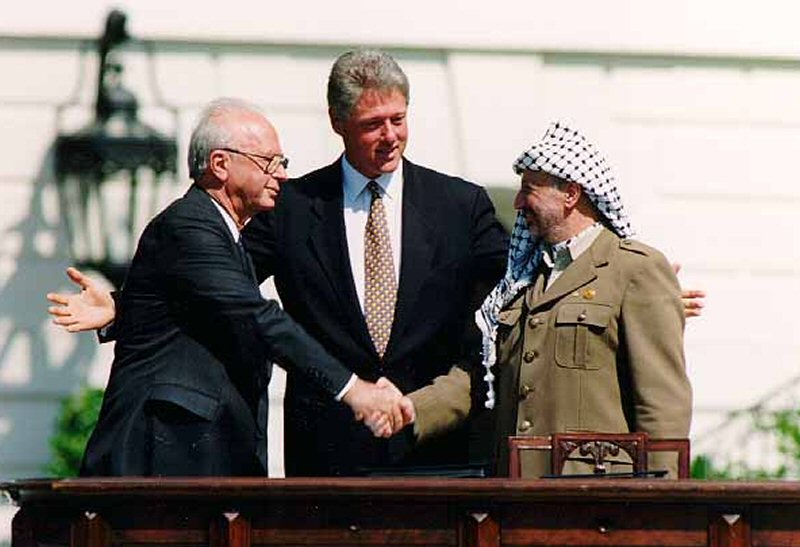by Hanaa Hasan
On September 13, 1993, Chairman of the Palestinian Liberation Organisation (PLO) Yasser Arafat and Israeli Prime Minister Yitzhak Rabin, shook hands after signing the Oslo peace accords, in what would become an iconic moment in the history of the Israeli-Palestinian conflict. Yet, 25 years later, the promise of peace remains unfulfilled and the struggle for a Palestinian homeland continues, with the failure of Oslo increasingly acknowledged.
What happened?
The famous handshake marked the final stage of months of secret peace talks conducted in Oslo, Norway between the Israeli government and leading Palestinian faction Fatah. Under the terms of the deal, Israel agreed to withdraw its troops from Gaza Strip and the occupied West Bank by April 1994. Elections were to be held in the territories to allow the Palestinians some form of autonomy and self-governance. In return, Chairman Arafat signed two letters renouncing violence and officially recognising 78 per cent of historical Palestine as Israel; Tel Aviv, in turn, withdrew their recognition of the PLO as a terrorist organisation, instead affirming them as the legitimate representative of the Palestinian people.
The issue of Jerusalem, settlements, Palestinian refugees, and the question of borders were among the responsibilities that would remain with Israel. The accords were also to preserve Israel’s exclusive control of the borders, the airspace and of Gaza’s waters.
The peace deal was due to be signed in Washington under the ushers of the administration of the US President Bill Clinton.
On 13 September 1993, Clinton introduced the two leaders, alongside other state officials and former US presidents Jimmy Carter and George Bush, to the crowd of invited guests in front of the White House. The two national heads did not sign the declaration themselves. Instead, Israeli Foreign Minister Shimon Peres and Palestinian counterpart Mahmoud Abbas did the signing to rapturous applause.
The two statesmen then turned to face one another, with President Clinton’s arms outstretched between them, before Arafat extended his hand first towards Rabin. The handshake prompted a standing ovation and cheers from the audience. Arafat then proceeded to shake hands with Peres and the other Israeli officials on stage, a move not reciprocated by Rabin.
In speeches delivered after the signing, Prime Minister Rabin then addressed the crowd of reporters and officials: “We who have fought against you the Palestinians, we say to you today in a loud and clear voice, enough of blood and tears, enough,” he proclaimed.
“The difficult decision we reached together was one that required great courage,” said Arafat in his subsequent speech. “Our two peoples are awaiting today this historic hope, and they want to give peace a real chance.”
What happened next?
The handshake made front page headlines across the world, hailed as a historic triumph of peace over conflict by media outlets and politicians. The signing of the Oslo Accords brought an end to the First Intifada, which had seen hundreds of Palestinians killed and thousands injured after Israel responded violently to the popular uprisings across the occupied territories.
In 1994 Arafat and Rabin received a Nobel Peace Prize for their participation in the accords. Arafat was also elected president of the newly established Palestinian Authority (PA) the same year, which paved the way for the signing of Oslo II in 1995, which affirmed the establishment of a Palestinian interim self-government. Neither accord promised future Palestinian statehood.
Twenty-five years on from the signing of the Oslo Accords, Israeli military withdrawal from the West Bank has never taken place. Israel has planted hundreds of military checkpoints, expanded illegal settlements that have seized large swathes of Palestinian farms and residential areas, built an illegal separation wall and evicted Palestinians from their homes and handed them to Israeli settlers.
The Israeli siege on Gaza, now in its 11th year, has made the Strip “unliveable” three years ahead of the UN’s dark prediction. Gaza was subjected to four major Israeli offensives between 2006 and 2014 that claimed the lives of thousands of Palestinian civilians, wounded tens of thousands others, devastated infrastructure, paralysed hospitals, destroyed schools and universities
The parties and sponsors of Oslo agreed to implement interim self-governance arrangements and a framework to facilitate the negotiations for the final status issues by the end of 1999. However, two and a half decades later, no progress has been made.
In 2015, Mahmoud Abbas told the UN General Assembly in New York that Palestine is still under occupation and that consequently the PA is no longer bound by the Oslo Accords signed with Israel.
Since the election of US President Donald Trump, negotiations for the “deal of the century” have been underway, with the administration finalising a plan that will allegedly end the conflict. Preliminary reports indicate that the peace deal will not call for a two-state solution and will not urge a “fair and just solution” to the issue of Palestinian refugees looking to return, as previous proposals have done.
~Middle East Monitor/Days of Palestine
(edited for the IMEMC by c h r i s @ i m e m c . o r g)
Opinion/Analysis 09/12/18 The Veiled Danger of the ‘Dead’ Oslo Accords

